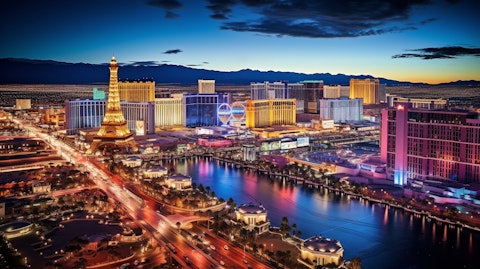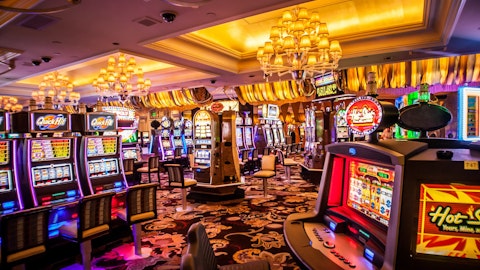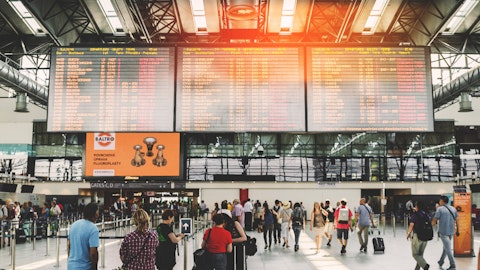Las Vegas Sands Corp. (NYSE:LVS) Q1 2024 Earnings Call Transcript April 17, 2024
Las Vegas Sands Corp. beats earnings expectations. Reported EPS is $0.75, expectations were $0.62. Las Vegas Sands Corp. isn’t one of the 30 most popular stocks among hedge funds at the end of the third quarter (see the details here).
Operator: Good day, ladies and gentlemen, and welcome to the Sands’ First Quarter 2024 Earnings Call. At this time, all participants have been placed on a listen-only mode. We will open the floor for your questions and comments following the presentation. It is now my pleasure to turn the floor over to Mr. Daniel Briggs, Senior Vice President of Investor Relations at Sands. Sir, the floor is yours.
Daniel Briggs: Thank you, Paul. Joining the call today are Rob Goldstein, our Chairman and CEO; Patrick Dumont, our President and COO; Dr. Wilfred Wong, Executive Vice Chairman of Sands China; and Grant Chum, CEO and President of Sands China and EVP of Asia Operations. Today’s conference call will contain forward-looking statements. We will be making these statements under the safe harbor provision of Federal Securities laws. The Company’s actual results may differ materially from the results reflected in those forward-looking statements. In addition, we will discuss non-GAAP measures. Reconciliations to the most comparable GAAP financial measure are included in our press release. We have posted an earnings presentation on our website.
We will refer to that presentation during the call. Finally, for the Q&A session, we ask those of interested to please pose one question and one follow-up so we might allow everyone with interest the opportunity to participate. This presentation is being recorded. I’ll now turn the call over to Rob.
Robert Goldstein: Thanks, Dan, and thanks for joining us today. The Macao market continues to grow as it has each in the past five quarters. Since the reopening in early 2023, the annual run rate of the market has grown every quarter from $17 billion in Q1 of last year to $22 billion, then $24 billion and $26 billion, now reaching $28 billion in annualized gaming revenue. We remain confident — so fully confident in the future growth of the Macao market. I’ve said in the past, Macao market will grow to $30 billion and then $35 billion and then $40 billion beyond in the years ahead, I remain steadfast in our belief. We remain equally confident in our business strategy to invest in both the quality and scale of our market-leading assets in Macao.
Our capital investment programs ensure that we will continue to be the market leader in the years ahead. Our investments position us to grow faster than the market over the long term to grow our share of EBITDA in the market and to generate industry-leading returns on invested capital. Turning to our current financial results for Macao. We delivered a solid result for the quarter despite the disruption of our ongoing capital investment programs. SCL continues to lead the market in gaming and non-gaming revenue and most importantly, in the market share of EBITDA. Because of our market-leading investments, we will capture high-value, high-margin tourism over the long run. We have a unique competitive position in terms of scale, quality and diversity of product offerings.

Upon completion of the second phase of the London and our co-tying redevelopment program, our product advantage will be more substantial than ever. Turning to Singapore, we delivered a record quarter. We believe it’s a record for the industry. So the team there has done an extraordinary job, and this is what happens when a superior product is located in the proper market. Our financial results in Singapore reflect the impact of our capital investment programs and our service capabilities. The appeal of Singapore as its tourist and destination and the robust entertainment and lifestyle event calendar also contributed to the growth at MBS. As we complete the balance of our investment programs, there will be a lot more runway for growth in the future.
Thanks for joining us today. I’ll turn it over to Patrick for more details.
Patrick Dumont: Thanks, Rob. Macao EBITDA was $610 million. If we had held as expected in our rolling program, our EBITDA would have been higher by $31 million. When adjusted for lower-than-expected holds in the rolling segment, our EBITDA margin would have been 34.4%, or up 380 basis points compared to the first quarter of 2023. This highlights our focus on cost discipline and profitability. The ongoing capital investment programs at The Londoner and at the Cotai Arena had an impact on our results this quarter. The Cotai Arena was closed for renovation in January this year. After the significant reinvestment and renovation, the arena is expected to reopen in November. In terms of the second phase of the Londoner, we have now commenced the room renovation on the first Sheraton.
We plan the completion of the first tower by year-end and of the second tower by Golden Week in May of 2025. The renovation of the casino on the Sheraton side of London will commence in May of this year with the reopening scheduled for December of 2024. While there will be ongoing disruption from these capital projects, as these products come online between the end of ’24 and the first half of ’25, our competitive position will be stronger than ever. The scale, quality and diversity of product will be better than we have ever offered before. They will be unmatched in the market. Turning to Singapore, MBS and EBITDA came in at $597 million, an all-time record for the property and for the industry. Our strong results reflect the impact of high-quality investment and market-leading products.
Had we held as expected in our Rolling Play segment, EBITDA would have been $77 million lower. Had we held as expected in the Rolling Play segment, MBS EBITDA margin would have been 49.1%, or 181 — 180 basis points higher than in Q1 of 2023. We have now completed both Tower 1 and Tower 2 of the Marina Bay Sands hotel refurbishment. While we have substantially completed the original $1 billion CapEx program, we are still in initial stages of realizing the benefits of these new products. We have now commenced the next phase of our capital investment program at Marina Bay Sands. The $750 million renovation that includes Tower 3. Tower 3 is scheduled to be completed by the second quarter of next year. This will support further growth in 2025 and beyond.
Turning to our program to return capital to shareholders. We repurchased $450 million of LVS stock during the quarter. We also paid our recurring quarterly dividend. In addition, LVS has completed the previously announced purchase of $250 million of SCL stock, which increases the parent company’s ownership interest in SCL to approximately 71%. We continue to see value in both repurchasing LVS stock and increasing our ownership interest in SCL. We look forward to continuing to utilize the company’s capital return program to increase return to shareholders in the future. Thanks again for joining the call today. Now, let’s take some questions.
See also 15 Best Low Cost ETFs and 14 Best Large Cap Dividend Growth Stocks To Buy Now.
Q&A Session
Follow Las Vegas Sands Corp (NYSE:LVS)
Follow Las Vegas Sands Corp (NYSE:LVS)
Operator: Thank you. Ladies and gentlemen, the floor is now open for questions. [Operator Instructions] And the first question today is coming from Stephen Grambling from Morgan Stanley. Stephen, your line is live.
Stephen Grambling: Hey, thanks so much. You talked to the March higher for the market in Macau, but this quarter looks like the margin flow through and EBITDA actually went in the other direction. How should we be thinking about flow through in Macau and operating expenses going forward in that market?
Patrick Dumont: Yeah. I just want to say one thing before we turn it over to Grant. I think some of this has to do in Macau with some of the disruption that we experienced during the quarter. So when we take the arena in January, we lose the benefit of our entertainment programs during a peak period. That did have an impact. So when you look at our operation, you compare it to Q1 of last year, Q1 of last year, we were coming out of the pandemic and it really took a while for visitation to get started again. This year, unfortunately, we did this to ourselves. We started renovating our arena. It’s a very powerful asset. It has lots of entertainment and went through the Chinese New Year period and unfortunately, with some hotel rooms out and the arena out, we felt on the revenue side.
So as we’ve said before, as the market continues to grow, we will do well. We have the best product. We’ve invested the most in non-gaming assets. We have the most amenities to offer to our patrons and they’re very high quality, diversity of retail, diversity of food and beverage, diversity of entertainment, which is very important. Unfortunately, we didn’t have that tool this quarter in full swing. We only had the London arena, which is good, but it can’t compete with the Cotai Arena. So I think for us, as the revenues continue to grow, as you’ve seen in prior quarters, our margins will fall in line. And you see that in the Venetian, as the revenues are where they need to be, the margins fall in line as well. So that’s sort of the headline from the margin performance this quarter.
I do want to turn it over to Grant to see if he has any additional color.
Grant Chum: Yeah. Thanks, Patrick. I think the most important point is still the GGR is growing in the market, and I think if you look at our profitability, at this level of GGR, I think we should be looking at low to mid-30s in operating margin — EBITDA margin, and we’re right at the high end of the range there. Obviously, each quarter there’s seasonality relating to different parts of the business, the revenue mix. So first quarter, I think 34.4% in terms of underlying margin is a really good number. I think 2024 is going to be one that is impacted by our capital works and the renovations that Patrick referenced also in his opening remarks. We have obviously, started the hotel renovation in the first half of Sheraton, and down — we’re probably down about 500, 600 rooms in the first quarter on average in that hotel.
But the number of keys that will be out of inventory will increase further in the second and third quarters. And of course, Cotai Arena, as Patrick referenced, that’s always been a core part of our content programming, our content offering, and we were able to offer plenty of shows at the London Arena. But if you just compare — just the sheer number of shows that we had in the first quarter, we had 12 shows compared with the fourth quarter last year, we had 31 shows. It’s a big difference. And obviously, in terms of capacity, there’s a big difference. So the attendance per show obviously was much higher in the fourth quarter as well. So hopefully, that gives you some color in terms of the disruption that had on our business with the arena being closed for renovation.
And as I said, the hotel renovation is ongoing and you’re going to see more keys out of inventory in the next couple of quarters.
Stephen Grambling: Got it. And maybe one clarification. I guess in the quarter, industry-wide, I’m not sure, maybe I missed this in the presentation or I haven’t seen the slides, but is VIP — the VIP actually grew faster than mass overall in the first quarter for the industry. And how are you thinking about base mass versus premium mass from here? I know you kind of touched on this a little bit, but would be curious about the industry-wide thought process.
Patrick Dumont: Rob, should I take that?
Robert Goldstein: Yes. Yes, please. Yes.
Patrick Dumont: Yes, you’re right. I think if you look at our slides, the mass revenues sequentially would be around 4%, and the overall GGR for the quarter grew at 6% sequentially. So yes, the VIP revenues in the market as a whole grew faster than the mass revenues Q-o-Q. I think in terms of the premium mass versus base mass, again, I think you can see it from our slides. Premium mass grew slightly faster for us in this quarter, but the difference is not material when you account for things like whole percentage and patron counts and so forth. So I wouldn’t say, there’s a material divergence in the growth rates between premium mass and base mass, and it’s part of business for the quarter.
Robert Goldstein: I think it’s important to note that — it’s important that the visitation still isn’t like it to be. Obviously, there’s still millions of people have not come versus the 2019 visitation numbers. We believe long-term visitation GGRs did grow, whether it be base or premium, we’ll get more than our fair share. And I think we’ve seen obviously, I’ll say the obvious, the promotional situation the market has changed and more people incent doing things. And once everyone starts playing that game, I believe that will resolve itself. We believe that assets will prevail. We believe London will be extraordinary asset much like it’s happening in Singapore. I think our results in Singapore reflect a fully developed program and the execution in Singapore shows what can be done.
We have the right kind of assets. What we have even done in Singapore the number is extraordinary. The same will happen in our business in Macao in time. As DGOs accelerate and they will, visitation accelerates and it will. We’ll continue to be margin-focused, even without focus, and get more than a fair share and assets will prevail over promotions from our perspective.
Stephen Grambling: Got it, thanks. I’ll jump back in the queue. Appreciate it.
Robert Goldstein: Thank you.
Operator: The next question is coming from Carlo Santarelli from Deutsche Bank. Carlo, your line is live.
Carlo Santarelli: Hey, guys. Thank you. Just following up on the first quarter margins. If I look at the fourth quarter, for example, and kind of extract the big element of turnover rent that comes in and obviously, very high flow through, it looks like margins are probably fairly similar. So it doesn’t seem like a lot changed on that front. Is that accurate? Or am I missing something else seasonally there?
Robert Goldstein: Primarily you’re correct. That’s a fair statement to make. The term red does, as you know, as you know to occur in the fourth quarter, and it’s material. Grant, do you want to add to that?
Grant Chum: Yes, it’s accurate. You’re right.
Carlo Santarelli: Great. Thank you. And if I could, just one follow-up on capital allocation. Obviously, over $400 million of buyback in this quarter. As you guys think about the capital needs here going forward, the stuff that you’ve announced, the stuff that obviously, is being contemplated and looking for budgets around and whatnot. Do you feel like that this pace is adequate and where you want to be as you look throughout the balance of this year?
Patrick Dumont: Yeah. So I think first off, I just want to say we see value in both equities. And I think, we have a very long-term bullish view given the market opportunity for growth, our market-leading investments and our assets, and just how we feel about the opportunities in both markets that we have. So as we said before, we’re going to be overweight share repurchases. As we think about future capital return, we are going to be more heavily weighted towards share repurchase and dividends. We think the repurchases are going to be more accretive than dividends over time and we want to shrink that denominator. And so I think we’re going to look to make purchases that are consistent with our share authorization by the Board and with prior practice.
And I think we’ll look to be a little bit opportunistic. We may vary levels, but I think we’re going to continue to be aggressive in the market. I mean, I think you see with the $450 million of LVS shares, the SCL share repurchases, we think this represents an interesting opportunity just a moment in time. And so we’re going to try to take advantage of it. We happen to have a very strong balance sheet. We have a lot of liquidity and we tend to put it to use. So I think we’re pretty happy with where the program has taken us so far — both so far and we’ll continue to use it and we’ll see how it goes across the year. But we’re going to look to repurchase more shares.
Carlo Santarelli: Thanks for that, Patrick. Just one aside. Guys, I’m not sure the slides are actually posted yet. It certainly could be a user error, but it looks like that they haven’t posted yet for the first quarter.
Patrick Dumont: Yeah, we’re working on it.
Carlo Santarelli: Thank you.
Operator: Thank you. The next question is coming from Joe Greff from J.P. Morgan. Joe, your line is live.
Joe Greff: Hey, everybody. I was hoping one of you could maybe help quantify the revenue and EBITDA impact from the renovations going on at Londoner and Cotai Arena. And then do you see that renovation disruption impact accelerating, and when do you start to see that decelerate? I know you kind of talked about the two towers and when they open up, but to kind of help understand that renovation impact in terms of how you’re seeing it, and I think would be helpful for everybody.
Patrick Dumont: Yeah. I don’t know that we can necessarily quantify accurately what the impact was because we can’t know what we displaced. You heard Grant describe the number of missing shows and the number of people typically will go to those shows in the Cotai Arena, and you get a sense of the type of high-quality patron that we bring in when we have live entertainment. And it is impactful. I think Q1 typically is a very powerful quarter for us as is Q4, and you kind of see the difference that the impact had for entertainment. We made a decision that if we take the arena offline and do it and make it the high — one of the highest-quality arenas in Asia, then in the long run, we will benefit from the entertainment. And so we decided to do it as quickly as possible.
And so that meant taking it offline in January this year and trying to get it done by October-November. And so once we do that, we’re going to have an incredibly high-quality arena with amenities that we’ve never had before. So it will make us more competitive in the market and actually drive additional high-quality tourism from both traditional markets and other markets and will also help drive high-quality tourism from our core customer base and allow for more repeat visits from our high-value customers. We’re very excited about the opportunities this new entertainment asset will present to us. Unfortunately, we’re going to take some pain while it’s offline, and that really started in January of this year. I can’t quantify the exact amount, but you hear the count from Grant and you realize that it is not immaterial.
And then the other side is, we’re taking the shared it out. And when we’re done, it’s going to be one of our best properties in Macao. The design will be high-level. The fundamentals of the Sheraton Tower are quite good and both towers are quite good. They’re actually a little bit better than the existing Londoner side, believe it or not. The layout of the casino will be very good. The additional food and beverage amenities that we can add. And I think the connectivity will be a very good driver of future results for that property. That’s the reason why we’re pretty confident that the result, when it’s done, will be that or exceed that of the Venetian. So I think for us, we’re doing it now. It is going to be disruptive. The worst is going to be across the summer when we have the lowest key count that we’ve had since we really opened what was then in Sands Cotai Central because we’re taking out — that we’re going to take the Sheraton out.
And so it’s going to be more of this disruption across the summer. But then hopefully, as keys come back online across the phasing, and as we get the arena back, let’s call it October-November, we’ll have a much more powerful set of assets to drive tourism and create cash flow. So there will be disruption. I can’t quantify it for you, but it’s not going to be immaterial. Grant, I don’t know if you have other things you’d like to add to that.
Grant Chum: I think you covered it perfectly. I think the only thing I supplement is Londoner phase one really gave us that elevation in the shared quality of product, as well as a very successful rebranding and repositioning of the entire property. But what phase two gives us is that scale of high-quality product and the diversity of it. And that’s when I think the earnings power of this resort will be fundamentally transformed.
Joe Greff: Perfect. And…
Robert Goldstein: I believe what we think once Londoner — we think once Londoner is done, Joe, we’ll have the one and two — number one and two assets in the GALP, by far. Not sure whether they’ll be fully in front, but that company really gives us a unique positioning for ’25 and the years ahead to dominate the market in terms of the largest resorts and those proper resorts, both one and two.
Joe Greff: Great. Thanks, Rob. You may have answered my follow-up question indirectly on your prior margin commentary, and maybe this is something Grant could talk about. But can you talk about the level of the markets, premium mass reinvestment levels? Has that been pretty consistent in the first quarter? And what you’re seeing year to date versus how the end of the year finished? Or is there any kind of trend change on that front? That’s all for me. Thanks.
Grant Chum: Thanks, Joe. For us, yes, our profitability, the structure of a margin in every segment actually, quarter-on-quarter very consistent. No significant changes there. And that obviously, fed through to the result that the earlier question described, which is that we had a very consistent margin quarter-on-quarter despite obviously, some inflation in the payroll costs due to holiday pay and salary increases.
Joe Greff: Yeah. My question — maybe I didn’t explain it that clearly. The level of premium mass reinvestment from your competitors, how would you characterize that year to date versus the end of last year?
Grant Chum: Oh. Sorry. You’re talking about the overall market now.
Joe Greff: Yes.
Robert Goldstein: Direct investment invested to customers.
Patrick Dumont: I think the promotion activities levels are relatively intense right now. Is it higher than Q4, I don’t think so, but it comes and goes and goes up and has ups and downs. But I think over time, there really isn’t any necessity in this market to be too aggressive on promotions. The demand and supply, supply-constrained market, the quality of supply is exceptional, and we are a big contributor to that. And as GGR rises, that becomes even less of an issue over time. And for us, it doesn’t matter. We stick to our strategy, which is as Rob referenced product based is driven off our asset base. The upgrades we’re making, the quality of the assets and the services that go with that in addition to the programming — the content programming, and like we talked about, we’re very big believers in that entertainment being co-offering.
That’s why we’re investing this $200 million in the upgrade of Cotai Arena. So — yeah, when it’s all said and done, we believe that GGR continues to rise, our asset base is going to be better than before and better than ever. And that’s the way we’re going to compete and that’s the only way we think we can compete on a sustainable and profitable basis is really based on the quality execution of a product and the service that go with that.
Joe Greff: Thank you.
Robert Goldstein: Joe, we’re obviously, keenly aware of the commercial environment down. We’re certainly aware of what’s happening with Macao promotions, but we remain steadfast. I believe that our product, once completed, will be superior. The scale is greater. The market will grow, and that’s how we’ll capture our fair share and remain focused on margins and keeping our EBITDA once again. So we’re not going to play the game of chasing $10 more for promotions. We don’t think it’s our business and who we are. We’re an asset-driven company with quality assets and scale. And again, we’ve proven that time and time again, and once Londoner is done, the arena will be just want to be in terms of market leading and margin of the assets and the cap.
Operator: Thank you. The next question is coming from Shaun Kelley from Bank of America. Shaun, your line is live.
Shaun Kelley: Hi. Good afternoon, everyone. Sorry if I’m beating the dead horse here, but I did want to just kind of stick with the margin commentary, but I’ll give it a little bit of a longer-term view. My question is really just trying to get a sense of what would it take to get back to let’s call it the mid to high thirties on margins here. Is what we’re seeing today and now increasingly expecting for the balance of ’24 more about customer mix? Or is it about sort of one time callouts around renovations and maybe some lost very high-margin non-gaming revenue?
Patrick Dumont: So it’s a very interesting question, and it’s the right question to ask. So as these properties reach run rates so as they reach their full potential, the margin should be upper 30s [Technical Difficulty] Sorry. I think someone in Sands China put us on hold. Please excuse us. So we think about margins in the upper thirties. If you look at the performance of the Venetian, that’s a good benchmark, right? It was impacted a little bit this quarter, again, also by the entertainment not being there in the Cotai Arena, but — and mix-wise, to be fair, pre-pandemic, it had more mass play and that’s a higher margin. And so as tourism returns, so as visitation increases, which has more mass play, and we have plenty of capacity for it.
So if you look at our asset base, the scale of the assets, the food and beverage we have, the amenities we have, we can accommodate a lot of mass play, and we have the positions to do it. And so for us, as visitation shows up and continues to on an upward trend, our assets are ready to take that visitation, revenue will grow, margins will grow, and they will normalize back towards a more traditional mix. That being said, the Londoner has the opportunity to also bring a lot of high-value tourism. So we’re carrying the expense base without the revenue, right? So we have the team members, we have the — we have all the things going on that you have, that we’re fully operating, but it’s not fully operating at. So the margins naturally are not going to look right.
So as the revenue comes in and as the visitation comes in, as the patrons come in, as the hotel is completed, and as the rest of the amenities are done, that will look more normal. The only problem is it’s in ’25. So we have a little bit of time that we have to get through with this investment. Are there some high-value things that are very high margin that we’re missing because of entertainment or keys out, yes, that’s true. But when you look at the asset base that we have, the experience that we have, the team that we have there, their ability to execute and how they’ve executed so far, and the asset base that we’re creating with these investments, we’re going to be in a great position. And the margins, we believe, will get there. So we need visitation to continue.





